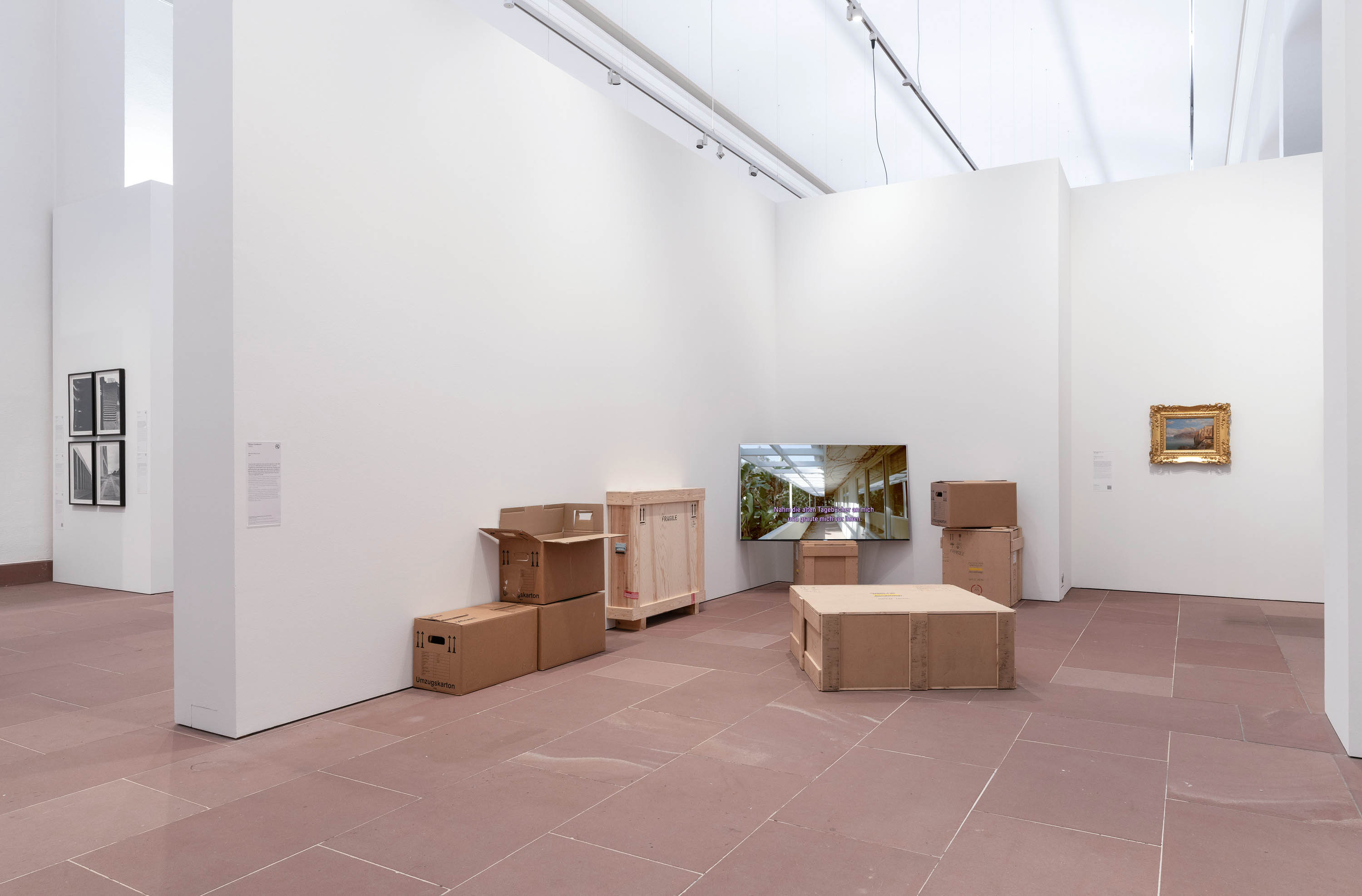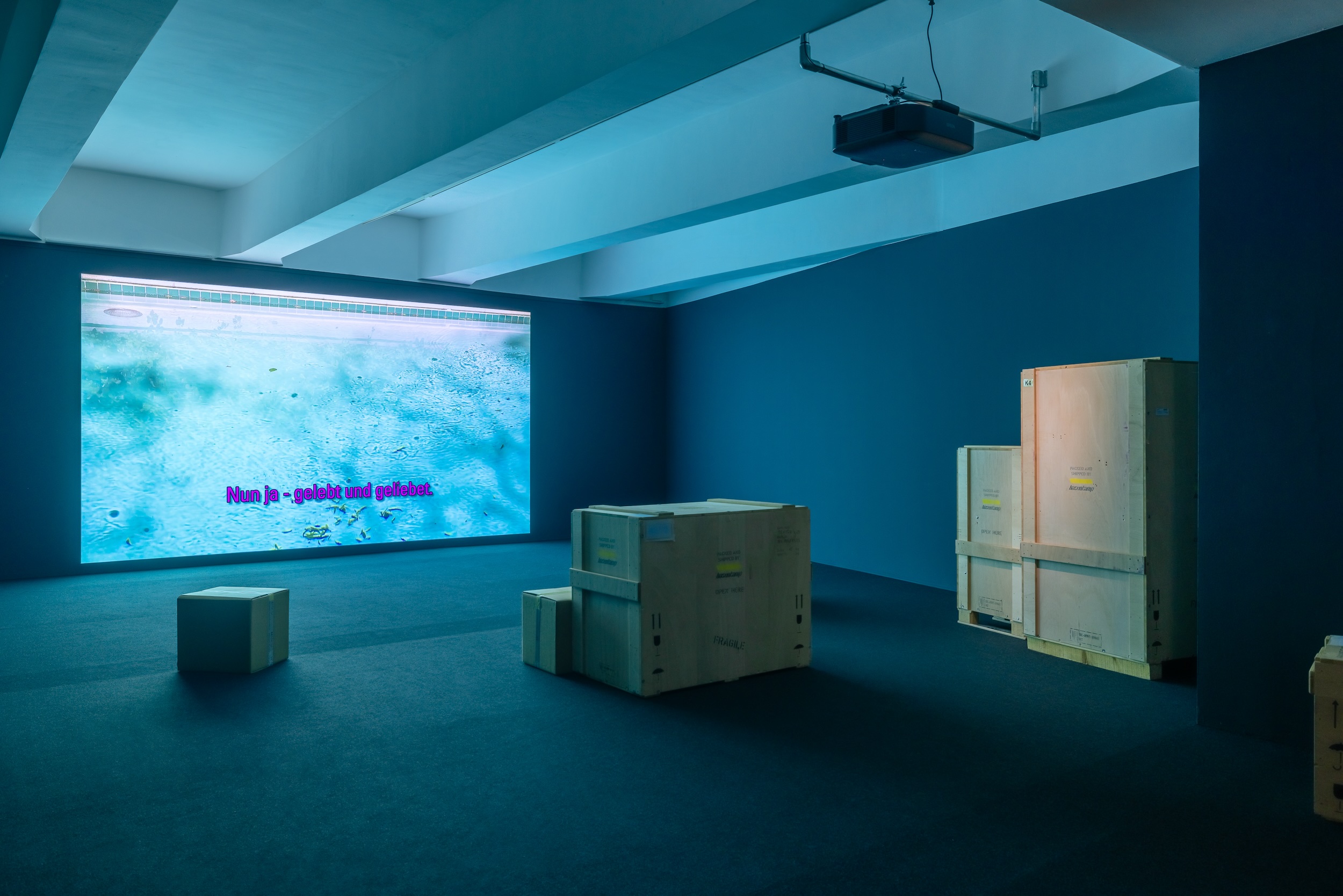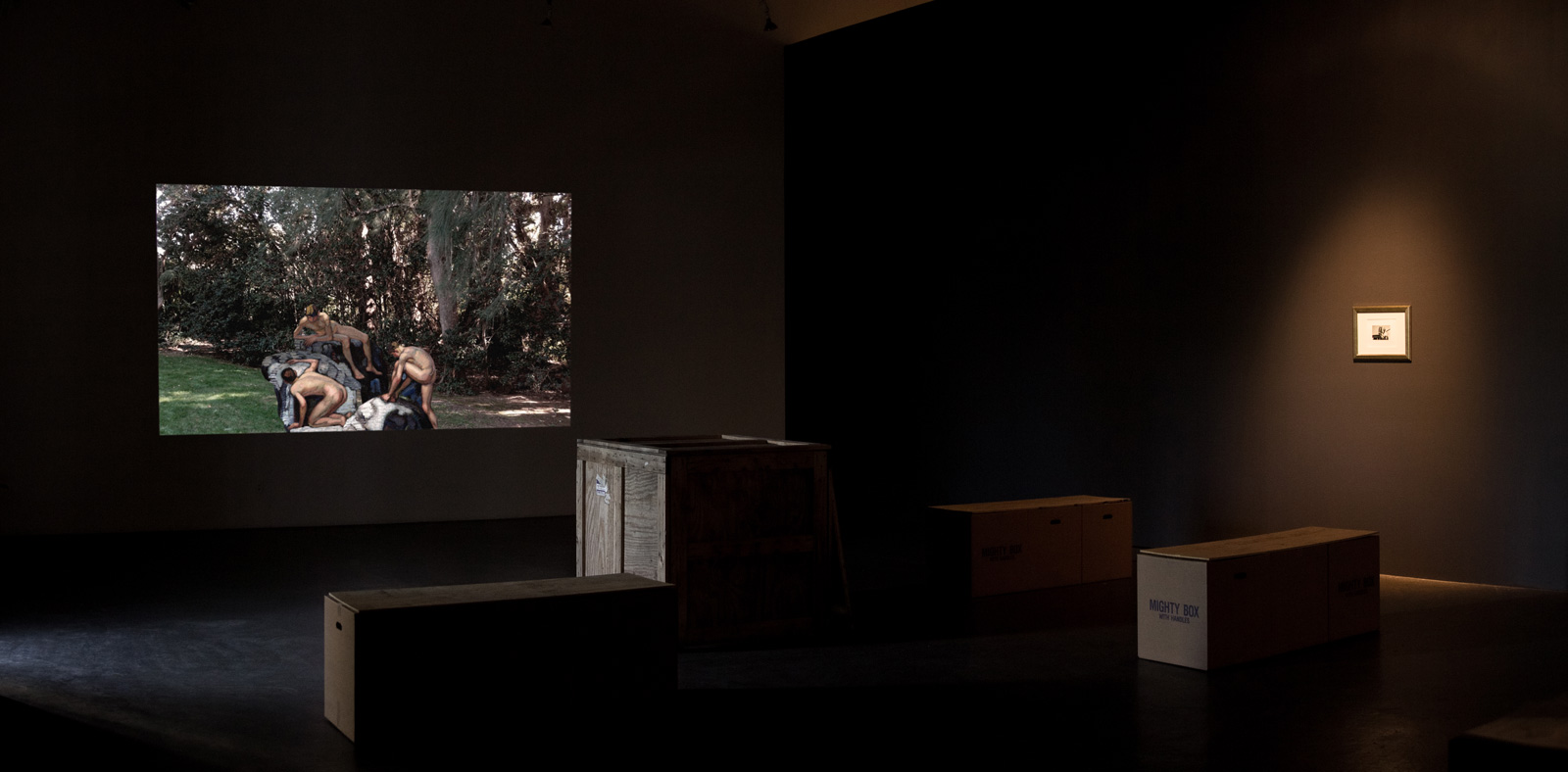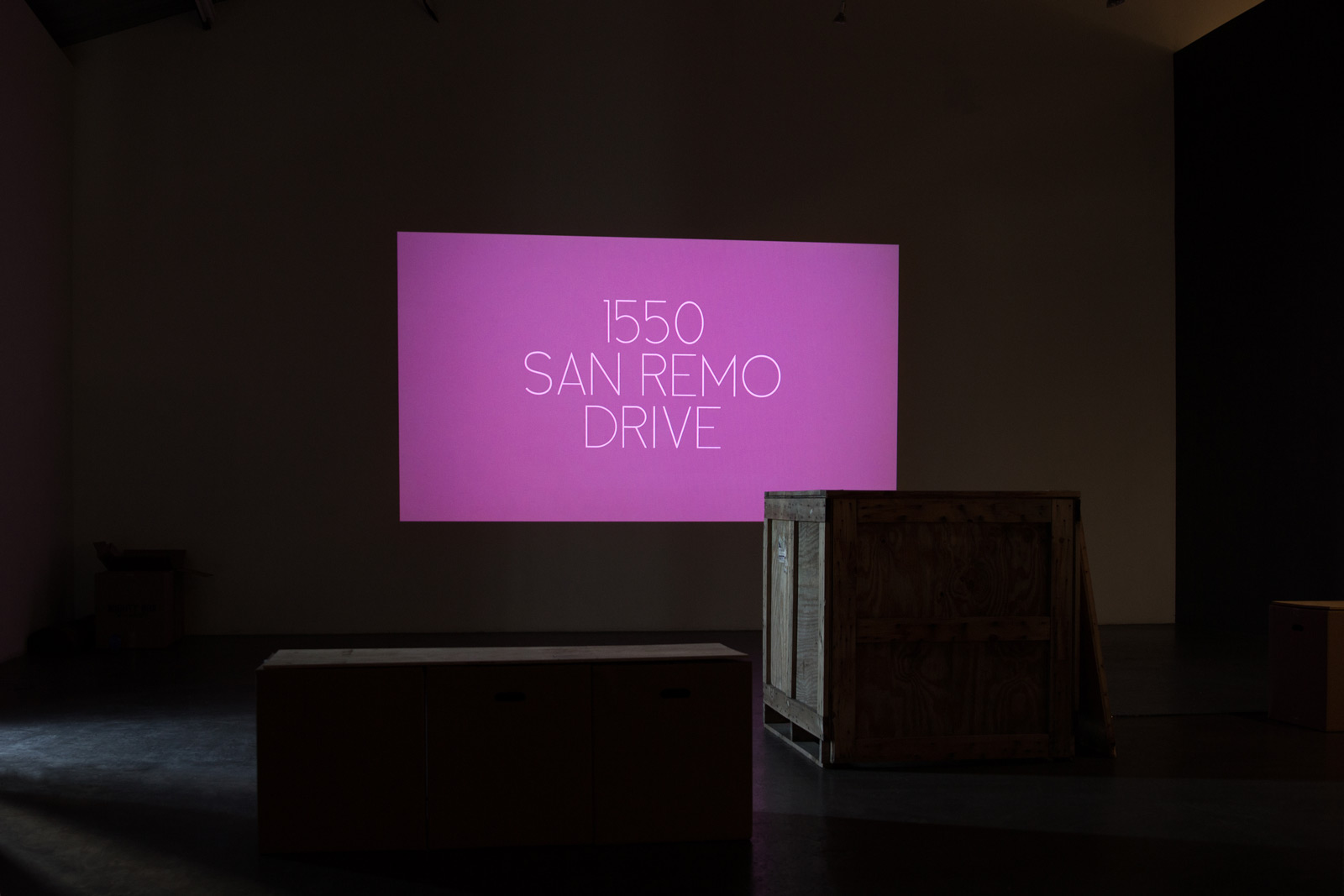


Video, 18:00 min, HD Video, Stereo, 2017
1550 San Remo Drive was filmed in February 2017 on the premises of the Thomas Mann House in Pacific Palisades, California, USA.
The building was designed by the modernist architect JR Davidson for the German writer Thomas Mann in 1941. Thomas Mann and his wife Katia lived in exile in California from 1942 to 1952, before emigrating to Switzerland, where they spent the last three years of his life. The house is 460 m2 and is located on a 4047 m2 plot. In 2016, the building was offered for sale for $16,995,000 as a demolition property. The facts that Thomas Mann had the house built and also had inhabited it went unmentioned in the advertisements. At the time of its potential sale, the house was not subject to any local historical protection orders.
1550 San Remo Drive reflects on personal, economical and representational desires and aspirations: The video features detailed shots of the uninhabited house before its recent renovation, quotes from Thomas Manns diaries (1940-1943) and advertisements from the real estate companies which marketed the house, before it was bought by the German government in November 2016 for $13.25 million .
The video explores the traces of homosexual desire in Thomas Mann’s work and life, considering today’s Thomas Mann House not only as a historically and politically charged site, but also as a place of queer resonance that challenges normative notions of identity, desire and the public sphere.
Niklas Goldbach & Friedel Schmoranzer, exhibition text "1550 San Remo Drive", Building Bridges Art Exchange, Los Angeles, 12/2017
1550 San Remo Drive wurde im Februar 2017 auf dem Gelände des “Thomas Mann House” in Pacific Palisades, Kalifornien, USA, gedreht.
Das Gebäude wurde von dem modernistischen Architekten JR Davidson für den deutschen Schriftsteller Thomas Mann im Jahre 1941 gebaut. Thomas Mann und seine Frau Katia lebten von 1942 bis 1952 im kalifornischen Exil, bevor sie in die Schweiz emigrierten, wo sie die letzten drei Jahre seines Lebens verbrachten. Das Haus ist 460 m2 gross und befindet sich auf einem 4047 m2 großen Grundstück.
Im Jahr 2016 wurde das Gebäude für $16,995,000 als Abbruch-Objekt zum Verkauf angeboten. Die Tatsachen, dass Thomas Mann das Haus bauen ließ und auch bewohnte, blieben in den Anzeigen unerwähnt. Zum Zeitpunkt des möglichen Verkaufs unterlag das Haus keinen örtlichen Denkmalschutzauflagen. Im November 2016 erwarb die Deutsche Bundesregierung das Haus für 13,25 Millionen Dollar.
Das Video verwendet Zitate aus Thomas Manns Tagebüchern (1940-1943), des Architekten JR Davidson und Anzeigen der Immobilienfirmen, die das Haus vermarkteten, bevor es von der deutschen Regierung gekauft wurde. Das Video zeigt Detailaufnahmen des unbewohnten Hauses vor seiner kürzlichen Renovierung, Zitate aus Thomas Manns Tagebüchern (1940-1943) und Anzeigen der Immobilienfirmen, die das Haus vermarkteten.
1550 San Remo Drive ist eine Auseinandersetzung mit persönlichen, wirtschaftlichen und repräsentativen Wünschen und Sehnsüchten.
Niklas Goldbach & Friedel Schmoranzer, Ausstellungstext „1550 San Remo Drive", Building Bridges Art Exchange, Los Angeles, 12/2017
| – |
[…] At the same time as Bakema, Thomas Mann was also keeping a diary – though under much more favourable auspices. Goldbach’s video 1550 San Remo Drive (2017) explores the house the German writer had built for himself while in Pacific Palisades, California, in 1942. The soundtrack uses quotes that Goldbach selected from Mann’s diaries from the period 1940–43. Commenting at length and somewhat pedantically on the planning and construction progress, they symbolise both the privilege of life in exile and the modernist dream of home ownership. In Europe’s Center Parcs, this dream was modularised, serialised and temporarily made affordable for everyone from the 1970s onwards […].
Inke Arns, excerpt from "The Paradise Machine - Of Towers and Foundation Pits in the Works of Niklas Goldbach"
Introductory text to the exhibition publication "The Paradise Machine", HMKV Dortmund, 16 March - 11 August 2024
[…] Zur selben Zeit wie Bakema in Compiègne schrieb auch Thomas Mann Tagebuch – jedoch unter ungleich besseren Umständen. Niklas Goldbachs Video 1550 San Remo Drive (2017) erkundet das Gebäude, das sich der deutsche Schriftsteller 1942 in Pacific Palisades in Kalifornien errichten ließ. Die von Goldbach ausgewählten Zitate aus Thomas Manns Tagebüchern (1940–1943), die sich detailliert bis penibel auf die Planungen und den Baufortschritt beziehen, stehen dabei sowohl für das privilegierte Leben im kalifornischen Exil wie auch für den modernistischen Traum vom Eigenheim. In den europäischen Center Parcs wird dieser Traum ab den 1970er Jahren modularisiert, vervielfältigt und temporär für alle erschwinglich […].
Inke Arns, Auszug aus „Die Paradiesmaschine - Von Türmen und Baugruben in den Arbeiten von Niklas Goldbach",
Einleitungstext zur Ausstellungspublikation „The Paradise Machine", HMKV Dortmund, 16.3.- 11.8.2024
| – |
1550 San Remo Drive was filmed in February 2017 at the Thomas Mann House in Pacific Palisades, California.
The video explores the house the German writer commissioned in 1942 while in exile in the U.S. Goldbach combines images of the uninhabited house (shortly before its refurbishment) with quotes from Mann’s diaries (1940–43). These are completed by quotes from the architect of the house, JR Davidson, and adverts by real estate agents marketing the house as a potential ‘teardown’ (without the slightest mention of Thomas Mann). Eventually, it was bought by the German government for US$13.25 million in November 2016. At the time of the sale, the house was not heritage-listed.
The quotes from Mann’s diaries, which comment at length and somewhat pedantically on the planning and construction progress, symbolise the privilege of life in exile. In 1942, Europe was in the midst of the Second World War, Germany had just attacked the Soviet Union, and the persecution of Jews and the Holocaust were stalking the continent.
Inke Arns, short text from the exhibition publication "The Paradise Machine", HMKV Dortmund, HMKV Dortmund, 16 March - 11 August 2024
1550 San Remo Drive wurde im Februar 2017 auf dem Gelände des Thomas Mann House in Pacific Palisades, USA, gefilmt.
Das Video erkundet das Gebäude, welches der deutsche Schriftsteller 1942 im kalifornischen Exil errichten ließ. Niklas Goldbach kombiniert die Bilder des unbewohnten Hauses (kurz vor der Renovierung) mit Zitaten aus Thomas Manns Tagebüchern (1940–1943). Außerdem verwendet er Zitate des Architekten JR Davidson und Anzeigen von Immobilienfirmen, die das Haus als potentiellen „Abriss“ vermarkteten (Thomas Mann wurde in den Annoncen noch nicht einmal erwähnt), bevor es im November 2016 von der deutschen Regierung für 13,25 Millionen Dollar gekauft wurde. Zum Zeitpunkt des Verkaufs stand das Haus nicht unter Denkmalschutz.
Die von Goldbach ausgewählten Zitate aus Thomas Manns Tagebüchern, die sich detailliert bis penibel auf die Planungen und den Baufortschritt beziehen, stehen dabei für das privilegierte Leben im Exil. Europa steckte 1942 mitten im Zweiten Weltkrieg, Deutschland hatte gerade die Sowjetunion angegriffen und es fanden Judenverfolgung und Holocaust statt."
Text: Inke Arns, Kurztext zur Ausstellungspublikation „The Paradise Machine", HMKV Dortmund, 16.3.- 11.8.2024
| – |
[…] Goldbach’s practice is rich in contrasts and paradoxes that unfold between what is considered human-made and from nature, and what, in consequence, we tend to accept as “natural.” His 2017 video 1550 San Remo Drive recounts the sale of a California house commissioned by the German writer Thomas Mann in 1941, offered for sale and eventually bought by the German government below the asking price in 2016.
Here, again, meticulous observation of the here-and-now blends with past narratives that are the driving force for some, while being of little con-sequence to others. […].Goldbach examines how human desire can propel our actions, while rarely adopting a direct moral stance. His readings of modernity, identity, the colonial and decolonial in their complexity, the exotic and self-exoticization, as well as the unconditional implication of both the viewers and himself in the narratives we are invited to experience, are never one-sided: at the verge of permanent daylight there is invariably a brooding darkness.
Krzysztof Kosciuczuk, excerpt from "Niklas Goldbach: The Paradise Machine", Exhibition Review, Camera Austria No.166, p 76
| – |
Sound Design: Christian Obermaier
Translation: Zaia Alexander
Filmed with support of Villa Aurora & Thomas Mann House e.V., http://www.vatmh.org
VIDEO EXCERPT (German Version)
VIDEO EXCERPT (English Version)
EXHIBITION VIEWS
Exhibition view:
ARCHISTORIES - Architektur in der Kunst, Staatliche Kunsthalle Karlsruhe, 29.11.2025 bis 12.04.2026
Curated by Kirsten Claudia Voigt
(Exhibition views 1 & 2. with Carl Ludwig Frommel)
Exhibition views:
"Niklas Goldbach: The Paradise Machine"
HMKV Hartware MedienKunstVerein Dortmund, 16.3. - 1.9.2024
Curated by Inke Arns
Photos 1 & 2: Roland Baege
Exhibition view:
"1550 San Remo Drive", Building Bridges Art Exchange, Bergamot Station Art Center, Los Angeles, USA
2.12.2017 - 1.1.2018
Curated by Friedel Schmoranzer

Presentation "Rencontres Internationales Paris/Berlin" Haus der Kulturen der Welt, Berlin, 8/2022
.jpg)
Premiere / Presentation "Villa Aurora & Thomas Mann House Night", Komische Oper Berlin, October 26th 2017 (Foto: Dirk Bleicker)
VIDEO STILLS

























